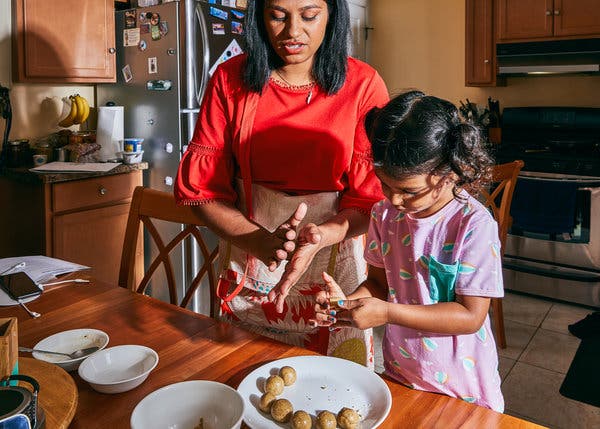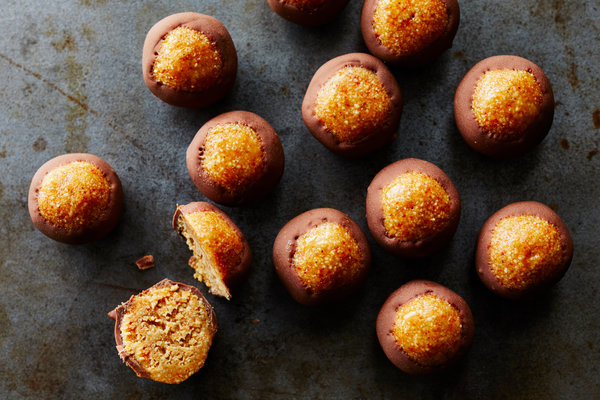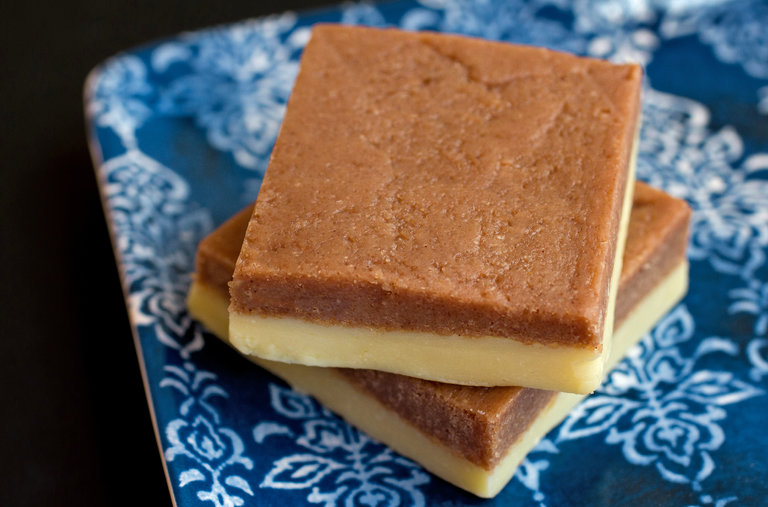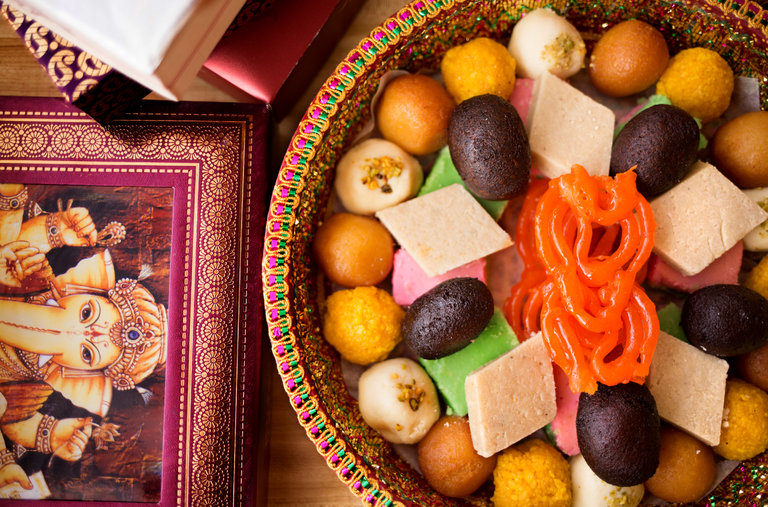BLOOMFIELD, N.J. — All Hetal Vasavada wanted when she was growing up in suburban New Jersey was to have cake on her birthday. One with pink buttercream frosting, flowers piped on the top and her name written in fancy cursive.
Instead, for her ninth birthday, her mother — an immigrant from Ahmedabad, Gujarat, in western India — made a large batch of seero, a semolina pudding typical of Gujarati cuisine, and placed candles in it.
Ms. Vasavada’s childhood home was decidedly devoid of birthday cake, or cookies (unless they were nankhatai, an Indian shortbread). The sweets that dominated the family’s kitchen table were burfi, candylike Indian confections made of milk, ghee, nuts and sugar. There were pendas, a milky sort of fudge and kopra pak, dense mounds of coconut, and there were rich, buttery spheres called peanut laddoos.

CreditJenny Huang for The New York Times
In Indian culture, burfi goes hand in hand with celebrations — weddings, graduations, births and even smaller victories, like getting a good test score.
But as a child, “I wanted anything but Indian food,” Ms. Vasavada said. She dreamed of licking cake batter off a spatula, as she saw families do in Duncan Hines commercials on television.
Yet on a recent morning at her parents’ kitchen here, where she was visiting with her 3-year-old daughter, Elara, in tow, she wasn’t frosting a birthday cake. She was making burfi.
These treats looked different. The kopra pak seemed airier, more like a macaroon. The pendas resembled thumbprint cookies, with chocolate puddles and flaky salt in the center. The peanut laddoos had a chocolate sheath.
These hybridized sweets make up Ms. Vasavada’s new dessert cookbook, “Milk & Cardamom,” released on Tuesday, which blends the flavors of her Indian heritage with her American upbringing. There are recipes for brown-butter ghee shortbread and mango lassi French macarons — but most compelling are her updates to burfi.
Ms. Vasavada, 32, began baking in college to pay for her tuition, after her parents lost their jobs working as cutters and sorters in the diamond industry. She went door to door in her dormitory selling sheet cakes and espresso brownies made from boxed mixes.
After school, she worked as a chemist and a health care consultant, but she longed to bake again. So in 2015, she quit her job, competed on the cooking show “MasterChef,” and a year later, started a blog, “Milk & Cardamom,” from her home in San Francisco.
Despite burfi’s ubiquity in Indian culture, Ms. Vasavada said her non-Indian friends never cared for it, insisting it was too sweet. The publisher of her cookbook, too, initially “only wanted cookies and cakes and tarts and more American-ish desserts,” she said, and not burfi.
“And the name is terrible,” she added, as kids used to tell her that they didn’t want to eat anything that sounded like “barf.”
She pushed back on the publisher’s request, explaining how she used to dip her mom’s peanut laddoos in Nutella, or squish chocolate chips into pendas or sprinkle salt over the top of coconut burfi to balance out the sweetness. “I thought, ‘This is how we introduce people in the West to burfi,’” she said.
Preeti Mistry, a chef who ran the Juhu Beach Club in Oakland, Calif., and Navi Kitchen in Emeryville, Calif. (both now closed), said she appreciated this approach. “She is highlighting specifically Indian techniques and bringing them forward, as opposed to just doing cardamom-infused polenta cake,” Ms. Mistry said.
Back in her parents’ kitchen in Bloomfield, Ms. Vasavada toasted milk powder for the penda mixture to give it a nutty flavor. Milk powder is a common element in burfi, but she learned the toasting technique from Christina Tosi, a judge on “MasterChef,” who often uses the ingredient in her nostalgia-inspired cakes and cookies at her Milk Bar bakeries.
On a stovetop, Ms. Vasavada combined the milk powder and dulce de leche. (She first tried dulce de leche when her parents opened a convenience store in 2008 in Cliffside Park, N.J., which has a large Latino population.) She tossed the mixture with a wooden spoon until it resembled peanut butter. Then she added ghee, milk, salt and cinnamon.
Ms. Vasavada’s mother, Champa Sheladia, 58, walked in and shook her head disapprovingly at the addition of salt. “In my mind, salt doesn’t go in burfi,” she said.
Ms. Vasavada greased her hands with ghee from a large stainless-steel container. She rolled the penda mixture out into small balls, flattened them a little, drizzled milk chocolate in the center and crowned the top with (to her mother’s dismay) even more salt.
For the laddoos, she blended toasted peanuts, jaggery, ghee and cardamom in a food processor, and formed the mixture into spheres, sneaking a little sample to her daughter. She dipped the balls in melted chocolate, her way of mimicking buckeyes, the peanut butter and chocolate treat popular in Ohio.
Finally, she made mawa, or milk solids, by cooking milk powder and heavy cream until bouncy. “This smells like my childhood,” she said.
She mixed the mawa with shredded coconut, and coconut oil, then slipped in an egg white. “Burfi is dense by nature,” she said, but the egg counters that. She baked the coconut morsels, coated the bottoms with chocolate and garnished them with pistachios.
“I find Indian desserts way easier to make than American desserts,” she said. “They are very forgiving.” Proportions can be inexact, and many don’t require baking.
That afternoon, Ms. Vasavada put out platters of burfi for her family to enjoy. Her daughter approached the table, carefully examining each variety. She picked up a chocolate-coated peanut laddoo, shoved the entire treat in her mouth, and grinned triumphantly.
Ms. Vasavada looked on, beaming.
Recipe: Peanut Laddoo Buckeye Balls








